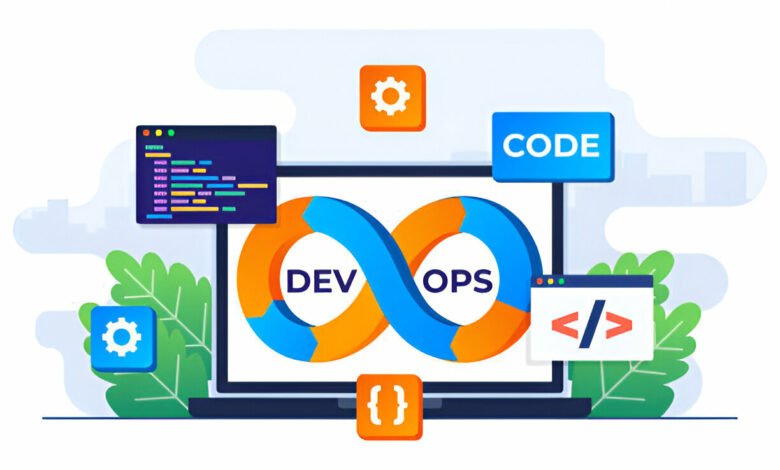
In today’s fast-paced software world, delivering high-quality apps quickly is important. This is where DevOps plays a big role. DevOps combines development and operations to help teams work together better, automate tasks, and create better software faster. Automation plays a significant role in every stage of the software lifecycle, from writing and testing code to deployment and monitoring.
By automating these stages, DevOps reduces errors, speeds up processes, and ensures consistent results, making it an essential practice in modern software development. Whether you are building a mobile app, a web application, or complex enterprise software, DevOps has become a necessary practice for success.
As the demand for efficient software development grows, the role of DevOps in app development and overall IT workflows has expanded significantly. It’s not just a set of tools but also a culture that integrates people, processes, and technology to achieve shared goals in software delivery.
What is DevOps?
DevOps means working together. It connects the development team (the people who make the software) and the operations team (the people who run it). DevOps helps teams build and maintain software by automating processes, improving communication, and speeding up delivery. But DevOps is not just about tools; it is a mindset that focuses on collaboration, speed, and quality.
Core Ideas of DevOps
- Teamwork: Developers and operations teams work closely together to achieve shared goals.
- Automation: Many tasks, like testing, deployment, and monitoring, are automated to save time and reduce human error.
- Continuous Improvement: Teams focus on making processes and products better with each iteration.
- Focus on Users: Ensuring the app meets user needs quickly and effectively is at the heart of DevOps.
In addition to these ideas, DevOps encourages innovation by freeing teams from repetitive tasks and enabling them to focus on creative solutions.
How Does DevOps Relate to Automating Processes in Software Development?
DevOps is all about making software development faster and easier. Devops Automation is one of its key pillars. Commonly automated tasks in DevOps include running tests to check code quality, deploying applications to servers, monitoring system performance, and scaling infrastructure to meet user demand. These automated processes ensure speed, reliability, and consistency throughout the development lifecycle. By automating repetitive tasks, such as code testing and deployment, teams can focus on solving real problems and building features. Automation reduces errors, speeds up delivery, and ensures consistent results.
Examples of Automation in DevOps
- Testing: Automated tests are run to catch bugs early and ensure code quality.
- Deployment: Code is deployed to servers automatically, reducing downtime and ensuring consistency.
- Monitoring: Tools keep track of app performance, alerting teams to any issues without manual effort.
- Scaling: Infrastructure can be scaled up or down automatically to handle changing workloads.
For example, imagine an e-commerce website preparing for Black Friday sales. Using tools like Terraform and Kubernetes, the DevOps team can automate scaling infrastructure to handle increased traffic. Additionally, monitoring tools such as Prometheus and Grafana ensure real-time tracking of server performance, while CI/CD pipelines allow quick fixes or feature updates without disrupting the user experience. These strategies not only prevent crashes but also maintain a smooth and reliable shopping experience for customers. DevOps automation ensures that infrastructure scales automatically to handle high traffic, preventing crashes and maintaining a smooth shopping experience.
Key Parts of DevOps in Software Development
1. Continuous Integration (CI)
In CI, developers frequently integrate their code into a shared repository. Automated builds and tests are run to detect errors early. This ensures that the new code works well with existing code.
- Tools for CI: Jenkins, GitLab CI, and CircleCI are popular choices.
- Benefits: Reduces integration issues and speeds up development cycles.
2. Continuous Delivery (CD)
CD ensures that software is always ready to be released. After passing tests, changes are automatically deployed to staging or production environments.
- Benefits: faster releases and more reliable updates.
- Tools for CD: Spinnaker, Bamboo, and Azure DevOps Pipelines.
3. Infrastructure as Code (IaC)
IaC treats infrastructure (like servers and networks) as code. Teams write scripts to set up infrastructure, ensuring consistency and making changes easier.
- Tools for IaC: Terraform, AWS CloudFormation, and Ansible.
- Benefits: Reduces manual effort and ensures consistent environments.
4. Monitoring and Feedback
DevOps teams use monitoring tools to track how the app performs. Feedback helps identify areas for improvement and resolve issues before users are affected.
- Tools for Monitoring: Prometheus, Grafana, and Nagios.
Effective monitoring doesn’t just identify problems; it also provides insights into how users interact with the software, enabling teams to optimize features for better user experiences.
The Role of DevOps in App Development
DevOps has transformed app development. Here are some ways it plays a key role:
- Teamwork: DevOps promotes better communication and collaboration between teams. Developers and operations work together to build apps that meet user expectations.
- Speed: With CI/CD pipelines and automation, teams can deliver updates and features faster than ever.
- Quality: Continuous testing and monitoring ensure fewer bugs and higher reliability.
- Focus on Users: DevOps makes it easier to respond to user feedback and release updates quickly.
For example, in web development, DevOps ensures that updates can be deployed without causing downtime, enabling businesses to remain competitive and responsive to user demands.
Benefits of DevOps in Software Development
DevOps offers a comprehensive approach to improving software development processes, enabling teams to deliver high-quality applications more efficiently and reliably.
1. Faster Updates
DevOps shortens the time it takes to deliver new features or fixes. Automated workflows allow teams to deploy changes quickly and confidently.
2. Better Quality
With automated testing and real-time monitoring, bugs are detected and fixed earlier. This leads to higher-quality software.
3. Lower Costs
By automating repetitive tasks, DevOps reduces manual work and minimizes costly errors.
4. Easier Scaling
DevOps tools like IaC make it simple to scale applications as user demands grow. Teams can add or remove resources automatically.
5. Happier Teams
DevOps fosters a culture of collaboration and shared responsibility, reducing stress and making work more enjoyable for everyone involved.
Challenges in DevOps
While DevOps offers many benefits, it is not without challenges.
1. Changing Mindsets
Some teams are used to working in silos. Adopting DevOps requires a cultural shift and a willingness to work collaboratively.
2. Old Systems
Integrating DevOps practices into legacy systems can be difficult and time-consuming.
3. Security Risks
Fast deployments can sometimes overlook security concerns. It is essential to integrate security into the DevOps process (DevSecOps).
4. Measuring Success
Tracking the impact of DevOps initiatives can be complex. Teams need to establish clear metrics to evaluate progress.
For example, measuring deployment frequency, lead time for changes, and incident recovery time can provide insights into the effectiveness of DevOps.
Best Practices for DevOps in Web Development
- Work as a Team: Developers and operations should align their goals and collaborate closely.
- Use the Right Tools: Invest in automation tools to streamline workflows.
- Keep Learning: Regular training helps teams stay updated on the latest DevOps practices.
- Monitor Everything: Continuous monitoring ensures issues are identified and resolved quickly.
- Focus on Security: Integrate security checks into every stage of the DevOps pipeline.
Case Studies of DevOps Success
1. Netflix
Netflix uses DevOps to manage its massive infrastructure. Automation and monitoring allow Netflix to deliver content seamlessly to millions of users worldwide.
2. Amazon
Amazon relies on DevOps for its e-commerce platform. With CI/CD pipelines, Amazon handles millions of transactions daily with minimal downtime.
3. Etsy
Etsy transformed its development process with DevOps. The company can now deploy updates multiple times a day, improving user experience and reducing downtime.
These success stories highlight the role of DevOps in software development and its ability to transform business operations. According to a 2023 study by Gartner, organizations that adopt DevOps practices see a 22% increase in deployment frequency and a 25% reduction in lead time for changes. This industry-wide trend showcases how DevOps has become a key driver of innovation and efficiency in modern software development.
Future Trends in DevOps
1. AI in DevOps
Artificial intelligence and machine learning will enhance automation, making DevOps processes smarter and more efficient.
2. DevSecOps
Integrating security into DevOps workflows will become more common, ensuring that apps are secure from the start.
3. Multi-Cloud DevOps
As more companies adopt multi-cloud strategies, DevOps will evolve to manage applications across multiple cloud providers.
Conclusion
DevOps has revolutionized the way software is developed and delivered. By combining teamwork, automation, and continuous improvement, it helps organizations build high-quality apps faster and more efficiently. Whether you are working on a small web app or a large enterprise system, DevOps can help you succeed. Now is the perfect time to embrace DevOps and transform your software development journey!











